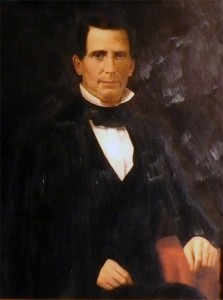Most of the downtown Birmingham, Alabama was once William F. Nabers’ farm
(Excerpt transcribed from Downtown Birmingham Architectural and Historical Walking Tour Guide, 2nd edition, by Marjorie Longenecker White)
In 1869 a frame dwelling was the only building standing on the original 4,150 acres which comprise today’s downtown Birmingham. Most of the area was once William F. Nabers’ farm land. It wouldn’t grow cotton or corn, but contained a treasure of mineral resources. In the 1850’s state geologist Michael Tuomey had surveyed the area and found immense deposits of iron and open seams of coal. Two railroads, the Alabama and Chattanooga and the South and North Alabama Railroad (later the Southern Railway System and the Louisville and Nashville) were under construction. At their crossing, something would happen.
Forming Elyton Land Company
In December 1870, ten men met in Montgomery to form the Elyton Land Company. They bought 4, 150 acres and planned to build a city at or near the town of Elyton, then the county seat of Jefferson County. Josiah Morris was their astute banker. Colonel James R. Powell became president of the land company and flamboyant promoter of the city-that-was-to-be. John T. Milner, chief engineer for the South and North Alabama Railroad, arranged the crossing of the tracks, not at Elyton, but a point east of Elyton which would be named Birmingham.
Josiah Morris
Downtown Birmingham’s city plan was drawn up in February of 1871. Major William P. Barker, a surveyor for the South and North Alabama Railroad, surveyed the proposed site and plotted a map showing streets, avenues, alleys and blocks with land systematically divided.
Col. James Powell
The grid plan was perfect for the impatient land speculators, because it was the fastest, most convenient and most economical means of land division. Not on a North-South axis, but parallel to the railroad tracks, straight, broad, 100-foot avenues were laid out with streets intersecting at right angles.
Nineteenth St., Looking South, Birmingham, Ala ca. 1890 (Alabama Department of Archives and History)
Alleys of 25 feel bisected each avenue, providing ventilation and delivery facilities for the houses and small businesses of the time and larger commercial structures of the future. Birmingham’s city plan showed three original parks, East, Central and West, now Guglielmo Marconi, Woodrow Wilson and Kelly Ingram. Colonel Powell envisioned Central Park as the site of the State Capitol buildings which he proposed to move to Birmingham.
Birmingham 1873 from top of Courthouse by photographer O. V. Hunt (from Samford University Library)
Tapestry of Love: Three Books In One – a historical fiction novel about the heritage of the Cottingham family who eventually settled in Bibb County, Alabama ca. 1818.
REVIEWS
The exhilarating action & subplots keep the reader in constant anticipation. It is almost impossible to put the book down until completion,
Dr. Don P. Brandon, Retired Professor, Anderson University, Anderson, Indiana
This is the first book I have read that puts a personal touch to some seemingly real people in factual events.
Ladyhawk
Love books with strong women…this has one. Love early American history about ordinary people…even though they were not ‘ordinary’…it took courage to populate our country. This book is well researched and well written.
Julia Smith
A picture of love and history rolled into one. A step back in time that pulls you in and makes you a part of the family and their world.










This is why it call the Naber Hood
now it’s just Da Hood … 😛
U 2 (Pugh & Bauer) should take your show on the road. Y’all are on the same “tract”. 😀
Bahahahhha
I wanted to read this but it says you have to open it with pattern for $2, not fair.